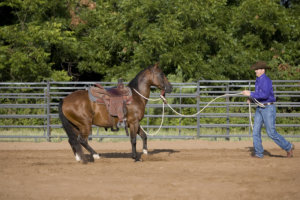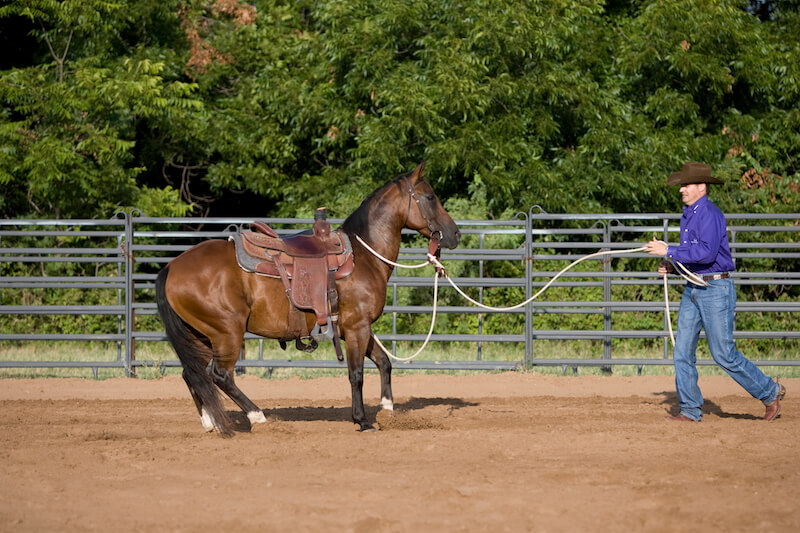Keys to Managing a Dangerous Problem
By Clinton Anderson
Rearing is a very dangerous situation for both horse and rider and if left uncorrected is a problem that only gets worse. The key to understanding how to fix your horse’s problem is to first understand that it’s just a symptom of a cause. A horse doesn’t rear for the fun of it; he rears because he falls into one of two categories:
- He’s hot and nervous and is using the reactive side of his brain. To make matters worse, his rider holds onto the reins with both hands, trying to force the horse to slow down and relax. However, since the horse is a prey animal, the more you say, “Don’t go!” and try to stop him by pulling back on the reins, the more trapped and claustrophobic he feels. In his mind, the only way he can escape is by going up in the air.
- He’s disrespectful and has sticky feet. When he doesn’t want to do something, his way of getting out of it is to run backwards or to rear up.
Gain His Respect on the Ground
 To gain a horse’s respect, you have to move his feet forwards, backwards, left and right and reward the slightest try. You need to spend more time working with him on the ground, establishing yourself as the leader. The Downunder Horsemanship Method contains over 30 groundwork exercises you can use to gain your horse’s respect and get him to use the thinking side of his brain, all of which makes him a willing partner.
To gain a horse’s respect, you have to move his feet forwards, backwards, left and right and reward the slightest try. You need to spend more time working with him on the ground, establishing yourself as the leader. The Downunder Horsemanship Method contains over 30 groundwork exercises you can use to gain your horse’s respect and get him to use the thinking side of his brain, all of which makes him a willing partner.
After working with hundreds of horses over the years, I’ve found that a week or two of consistent groundwork usually cures rearing before you get back in the saddle. Why? Because the horse’s respect is earned on the ground by moving his feet, he’s using the thinking side of his brain, and he is no longer fearful.
When a horse panics and uses the reactive side of his brain, only use one rein to control him, and concentrate on getting him to use the thinking side of his brain by doing lots of changes of direction.
Get Back in Control
The best way to gain immediate control of the situation is to yield his hindquarters. When a horse crosses his back legs over one another, it takes away his balance. Without balance, the horse can’t stand on his hind legs and rear. Think of yielding the horse’s hindquarters like pushing the clutch in on a car, you’re taking the power away from the horse. Yielding the hindquarters also makes the horse concentrate on where he’s placing his feet.
Get Those Feet Moving
When a horse rears because he has sticky feet and doesn’t want to go forward, it’s a lack of control on the rider’s part. You first need to get control of the horse on the ground and then practice basic impulsion exercises like the Cruising Lesson to teach the horse to respond to your cues and to be responsible for maintaining the gait you set him in.
Do the Opposite of What He Wants to Do
If your horse is rearing because he doesn’t want to go somewhere, use a little reverse psychology on him. Don’t think, “How can I make the horse move?” Think, “How can I make it uncomfortable for him not to go the direction that I want?”
For example, if the horse tries to rear up when you go to ride him away from the barn, work him hard at the barn. Using one rein to direct him, hustle his feet. You can do a lot of serpentines by bending the horse with your left hand and left leg, or going the opposite way, your right hand and right leg. Rollbacks, cantering the horse off, bringing him to a stop and rolling him over his hocks to change directions are also a great exercise in this situation.
Build a Solid Foundation
A horse that constantly rears is a horse with a lack of foundation. You need to establish better basics and prove to your horse that you’re a capable leader. Once you get your horse using the thinking side of his brain and earn his respect, you’ll find that the problem will fix itself.
Published September 2011 Issue

The Northwest Horse Source is an independently owned and operated print and online magazine for horse owners and enthusiasts of all breeds and disciplines in the Pacific Northwest. Our contemporary editorial columns are predominantly written by experts in the region, covering the care, training, keeping and enjoyment of horses, with an eye to the specific concerns in our region.






